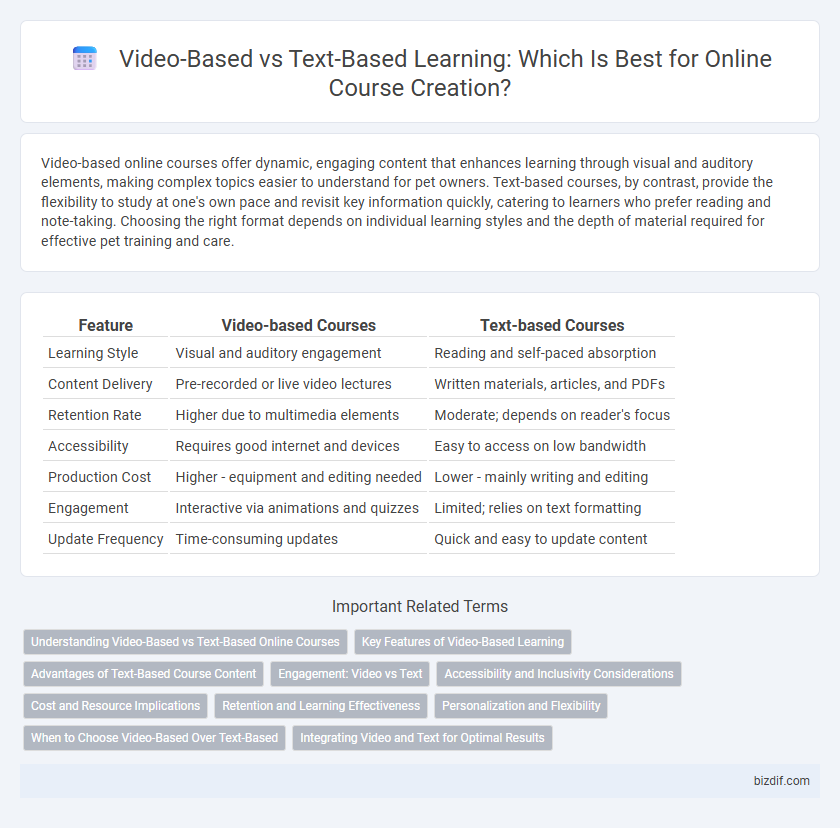Video-based online courses offer dynamic, engaging content that enhances learning through visual and auditory elements, making complex topics easier to understand for pet owners. Text-based courses, by contrast, provide the flexibility to study at one's own pace and revisit key information quickly, catering to learners who prefer reading and note-taking. Choosing the right format depends on individual learning styles and the depth of material required for effective pet training and care.
Table of Comparison
| Feature | Video-based Courses | Text-based Courses |
|---|---|---|
| Learning Style | Visual and auditory engagement | Reading and self-paced absorption |
| Content Delivery | Pre-recorded or live video lectures | Written materials, articles, and PDFs |
| Retention Rate | Higher due to multimedia elements | Moderate; depends on reader's focus |
| Accessibility | Requires good internet and devices | Easy to access on low bandwidth |
| Production Cost | Higher - equipment and editing needed | Lower - mainly writing and editing |
| Engagement | Interactive via animations and quizzes | Limited; relies on text formatting |
| Update Frequency | Time-consuming updates | Quick and easy to update content |
Understanding Video-Based vs Text-Based Online Courses
Video-based online courses offer dynamic visual and auditory learning experiences that enhance retention and engagement through demonstrations and real-time explanations. Text-based courses provide flexible, searchable content that supports self-paced study and detailed reference, ideal for learners who prefer reading and note-taking. Selecting between video and text depends on learners' preferences and the course objectives, with many effective programs integrating both formats to optimize comprehension and accessibility.
Key Features of Video-Based Learning
Video-based learning enhances engagement through dynamic visual and auditory content, enabling learners to absorb information more effectively compared to text-based formats. Key features include demonstration of complex concepts via animations, real-time instructor presence for personalized communication, and the ability to pause, replay, and interact with multimedia components. This approach supports diverse learning styles and improves knowledge retention through immersive, multisensory experiences.
Advantages of Text-Based Course Content
Text-based course content offers enhanced accessibility, allowing learners to study at their own pace and easily revisit material without the need for advanced technology or large data usage. It supports better keyword indexing and searchability, improving SEO and making course material more discoverable to a broader audience. Additionally, text-based content can be quickly updated and customized, ensuring accuracy and relevance in a rapidly changing learning environment.
Engagement: Video vs Text
Video-based course content significantly boosts learner engagement by combining visual and auditory stimuli, which enhances information retention and keeps students motivated. Text-based content provides flexibility for self-paced study and is ideal for learners who prefer detailed, referenceable material but may lack the immersive experience offered by video formats. Studies show video learners exhibit up to 60% higher engagement rates compared to text-only courses, making video a preferred choice for interactive and dynamic online education.
Accessibility and Inclusivity Considerations
Video-based online courses enhance accessibility by catering to diverse learning styles through visual and auditory content, supporting learners with reading difficulties or limited literacy skills. Text-based courses offer flexibility for screen readers and can be easily translated, promoting inclusivity for non-native speakers and individuals with hearing impairments. Combining both formats maximizes accessibility, ensuring content is reachable for learners with various disabilities and preferences.
Cost and Resource Implications
Video-based online course creation typically incurs higher costs due to expenses related to filming equipment, professional editing software, and potential hiring of videographers or actors. Text-based courses require fewer resources, primarily needing content writers and editors, making them more budget-friendly and quicker to produce. While video content demands significant time investment for production and post-production, text-based formats allow for easier updates and scalability.
Retention and Learning Effectiveness
Video-based courses typically enhance retention by engaging visual and auditory learners, making complex concepts easier to understand through demonstrations and animations. Text-based content supports better retention for learners who prefer reading at their own pace and revisiting material for deeper comprehension. Combining both formats optimizes learning effectiveness by catering to diverse cognitive styles and reinforcing knowledge through multiple sensory channels.
Personalization and Flexibility
Video-based online courses offer high personalization through visual and auditory engagement, catering to diverse learning styles and enabling instructors to demonstrate concepts vividly. Text-based courses provide greater flexibility, allowing learners to consume material at their own pace and easily revisit specific sections for deeper understanding. Both formats support adaptable learning experiences, but video excels in interactive personalization while text ensures convenient, self-directed study.
When to Choose Video-Based Over Text-Based
Video-based courses excel in demonstrating complex concepts that benefit from visual and auditory explanations, making them ideal for subjects like software tutorials, language learning, or creative skills. Learners who prefer engaging, step-by-step guidance often retain information better through video content, especially when body language, tone, or immediate problem-solving is crucial. Choose video-based formats when learners require dynamic interaction, practical demonstrations, or motivational cues that text alone cannot effectively deliver.
Integrating Video and Text for Optimal Results
Integrating video and text in online course creation maximizes learner engagement and retention by catering to diverse learning preferences. Video content delivers dynamic demonstrations and emotional connection, while text provides detailed explanations and easy reference. Combining both formats enhances comprehension, reinforces key concepts, and supports varied pacing for optimal educational outcomes.
Video-based vs Text-based Infographic

 bizdif.com
bizdif.com